Management Accounting Report: Cost Analysis and Financial Statements
VerifiedAdded on 2022/12/29
|19
|4264
|25
Report
AI Summary
This report provides a comprehensive overview of management accounting, focusing on cost analysis and financial statement preparation. It begins by defining management accounting and its essential requirements, contrasting it with financial accounting, and exploring different types of management accounting systems like cost accounting and inventory management. The report then delves into various management accounting reporting methods, including budget reports, job cost reports, and performance reports. Furthermore, it demonstrates cost calculation using marginal and absorption costing techniques to prepare income statements, along with break-even analysis and variance analysis. The report includes detailed calculations, income statements, and a break-even graph, providing a thorough understanding of the practical application of management accounting principles. This report is a valuable resource for students and professionals seeking to understand the core concepts and techniques used in management accounting.
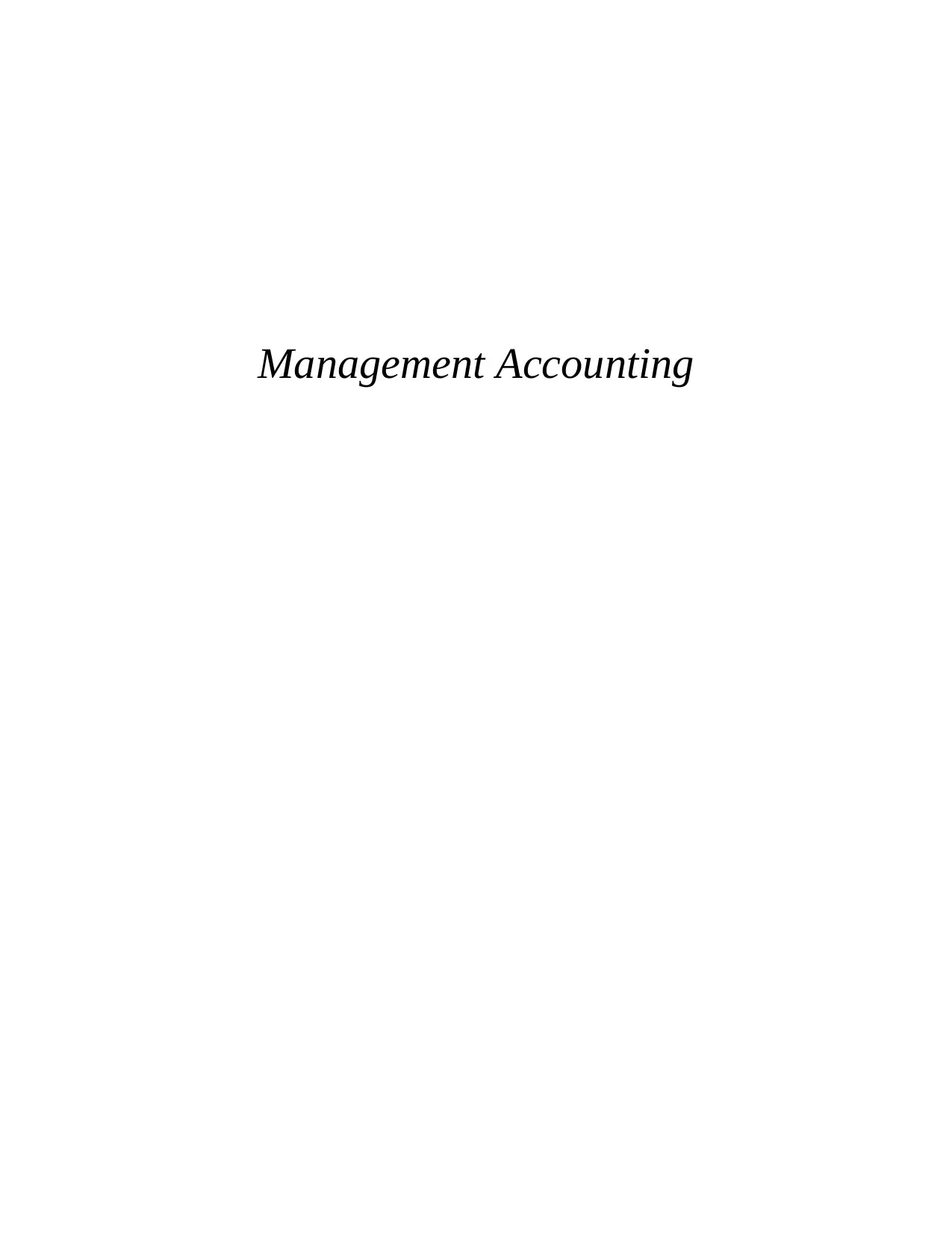
Management Accounting
Paraphrase This Document
Need a fresh take? Get an instant paraphrase of this document with our AI Paraphraser

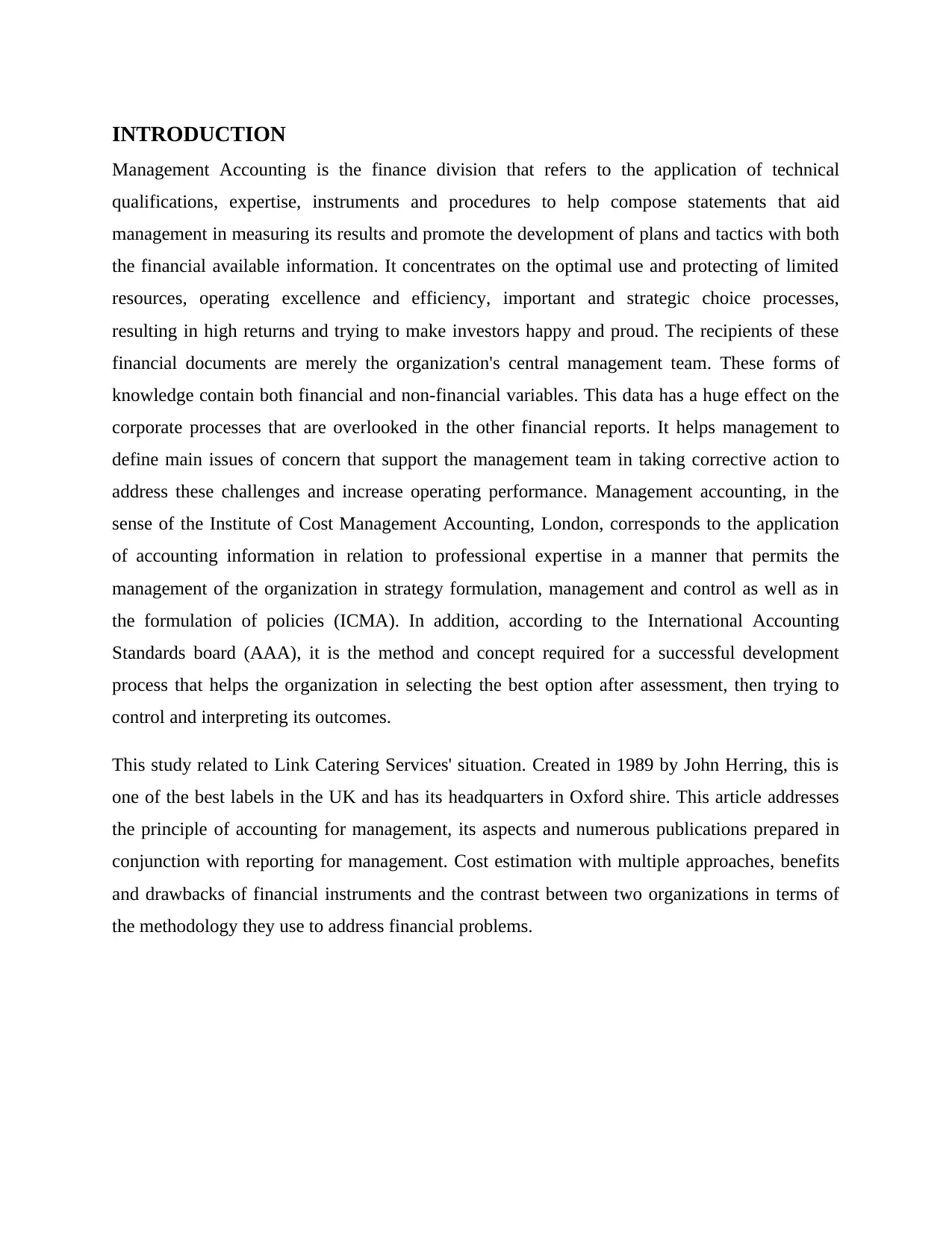
INTRODUCTION
Management Accounting is the finance division that refers to the application of technical
qualifications, expertise, instruments and procedures to help compose statements that aid
management in measuring its results and promote the development of plans and tactics with both
the financial available information. It concentrates on the optimal use and protecting of limited
resources, operating excellence and efficiency, important and strategic choice processes,
resulting in high returns and trying to make investors happy and proud. The recipients of these
financial documents are merely the organization's central management team. These forms of
knowledge contain both financial and non-financial variables. This data has a huge effect on the
corporate processes that are overlooked in the other financial reports. It helps management to
define main issues of concern that support the management team in taking corrective action to
address these challenges and increase operating performance. Management accounting, in the
sense of the Institute of Cost Management Accounting, London, corresponds to the application
of accounting information in relation to professional expertise in a manner that permits the
management of the organization in strategy formulation, management and control as well as in
the formulation of policies (ICMA). In addition, according to the International Accounting
Standards board (AAA), it is the method and concept required for a successful development
process that helps the organization in selecting the best option after assessment, then trying to
control and interpreting its outcomes.
This study related to Link Catering Services' situation. Created in 1989 by John Herring, this is
one of the best labels in the UK and has its headquarters in Oxford shire. This article addresses
the principle of accounting for management, its aspects and numerous publications prepared in
conjunction with reporting for management. Cost estimation with multiple approaches, benefits
and drawbacks of financial instruments and the contrast between two organizations in terms of
the methodology they use to address financial problems.
Management Accounting is the finance division that refers to the application of technical
qualifications, expertise, instruments and procedures to help compose statements that aid
management in measuring its results and promote the development of plans and tactics with both
the financial available information. It concentrates on the optimal use and protecting of limited
resources, operating excellence and efficiency, important and strategic choice processes,
resulting in high returns and trying to make investors happy and proud. The recipients of these
financial documents are merely the organization's central management team. These forms of
knowledge contain both financial and non-financial variables. This data has a huge effect on the
corporate processes that are overlooked in the other financial reports. It helps management to
define main issues of concern that support the management team in taking corrective action to
address these challenges and increase operating performance. Management accounting, in the
sense of the Institute of Cost Management Accounting, London, corresponds to the application
of accounting information in relation to professional expertise in a manner that permits the
management of the organization in strategy formulation, management and control as well as in
the formulation of policies (ICMA). In addition, according to the International Accounting
Standards board (AAA), it is the method and concept required for a successful development
process that helps the organization in selecting the best option after assessment, then trying to
control and interpreting its outcomes.
This study related to Link Catering Services' situation. Created in 1989 by John Herring, this is
one of the best labels in the UK and has its headquarters in Oxford shire. This article addresses
the principle of accounting for management, its aspects and numerous publications prepared in
conjunction with reporting for management. Cost estimation with multiple approaches, benefits
and drawbacks of financial instruments and the contrast between two organizations in terms of
the methodology they use to address financial problems.
⊘ This is a preview!⊘
Do you want full access?
Subscribe today to unlock all pages.

Trusted by 1+ million students worldwide
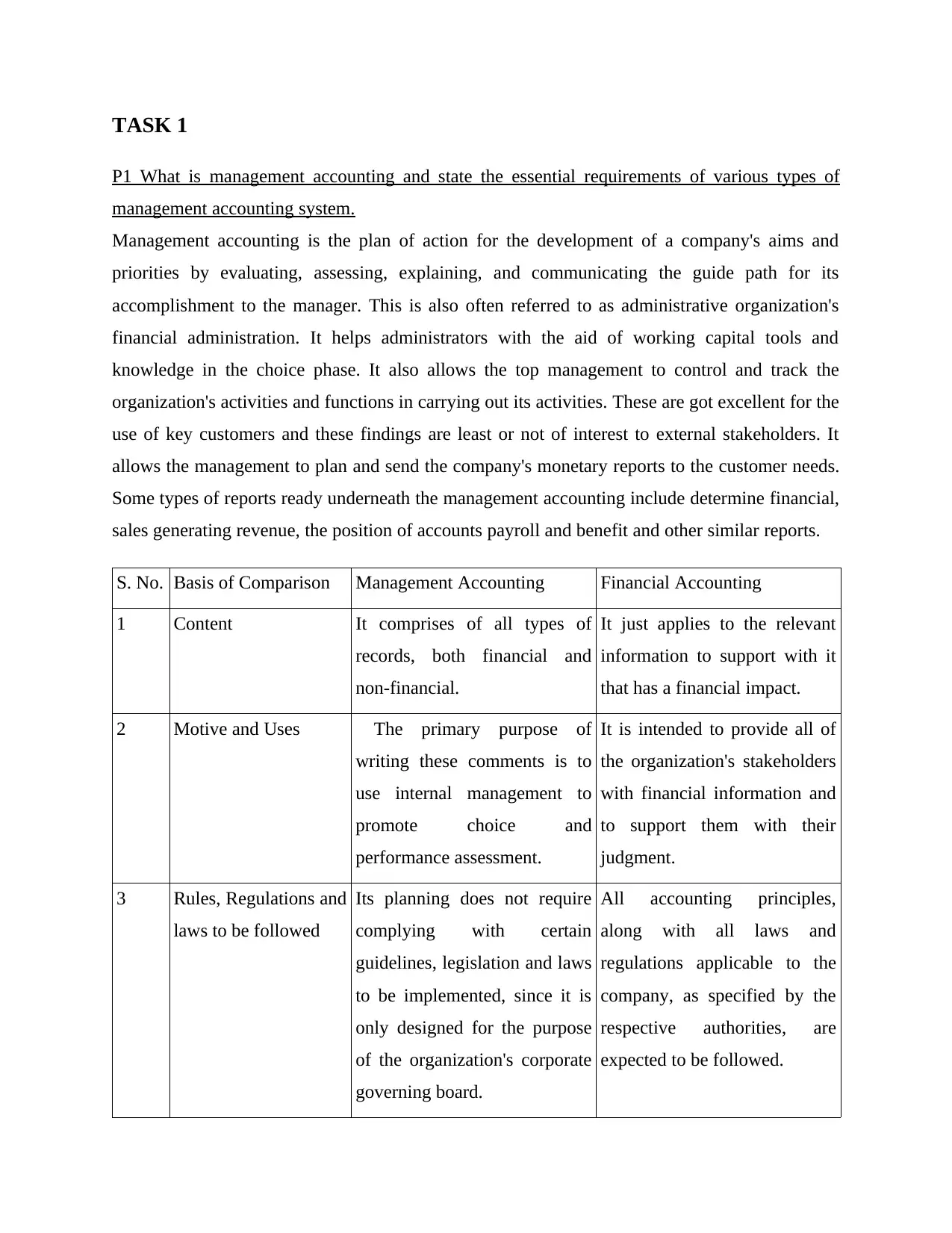
TASK 1
P1 What is management accounting and state the essential requirements of various types of
management accounting system.
Management accounting is the plan of action for the development of a company's aims and
priorities by evaluating, assessing, explaining, and communicating the guide path for its
accomplishment to the manager. This is also often referred to as administrative organization's
financial administration. It helps administrators with the aid of working capital tools and
knowledge in the choice phase. It also allows the top management to control and track the
organization's activities and functions in carrying out its activities. These are got excellent for the
use of key customers and these findings are least or not of interest to external stakeholders. It
allows the management to plan and send the company's monetary reports to the customer needs.
Some types of reports ready underneath the management accounting include determine financial,
sales generating revenue, the position of accounts payroll and benefit and other similar reports.
S. No. Basis of Comparison Management Accounting Financial Accounting
1 Content It comprises of all types of
records, both financial and
non-financial.
It just applies to the relevant
information to support with it
that has a financial impact.
2 Motive and Uses The primary purpose of
writing these comments is to
use internal management to
promote choice and
performance assessment.
It is intended to provide all of
the organization's stakeholders
with financial information and
to support them with their
judgment.
3 Rules, Regulations and
laws to be followed
Its planning does not require
complying with certain
guidelines, legislation and laws
to be implemented, since it is
only designed for the purpose
of the organization's corporate
governing board.
All accounting principles,
along with all laws and
regulations applicable to the
company, as specified by the
respective authorities, are
expected to be followed.
P1 What is management accounting and state the essential requirements of various types of
management accounting system.
Management accounting is the plan of action for the development of a company's aims and
priorities by evaluating, assessing, explaining, and communicating the guide path for its
accomplishment to the manager. This is also often referred to as administrative organization's
financial administration. It helps administrators with the aid of working capital tools and
knowledge in the choice phase. It also allows the top management to control and track the
organization's activities and functions in carrying out its activities. These are got excellent for the
use of key customers and these findings are least or not of interest to external stakeholders. It
allows the management to plan and send the company's monetary reports to the customer needs.
Some types of reports ready underneath the management accounting include determine financial,
sales generating revenue, the position of accounts payroll and benefit and other similar reports.
S. No. Basis of Comparison Management Accounting Financial Accounting
1 Content It comprises of all types of
records, both financial and
non-financial.
It just applies to the relevant
information to support with it
that has a financial impact.
2 Motive and Uses The primary purpose of
writing these comments is to
use internal management to
promote choice and
performance assessment.
It is intended to provide all of
the organization's stakeholders
with financial information and
to support them with their
judgment.
3 Rules, Regulations and
laws to be followed
Its planning does not require
complying with certain
guidelines, legislation and laws
to be implemented, since it is
only designed for the purpose
of the organization's corporate
governing board.
All accounting principles,
along with all laws and
regulations applicable to the
company, as specified by the
respective authorities, are
expected to be followed.
Paraphrase This Document
Need a fresh take? Get an instant paraphrase of this document with our AI Paraphraser
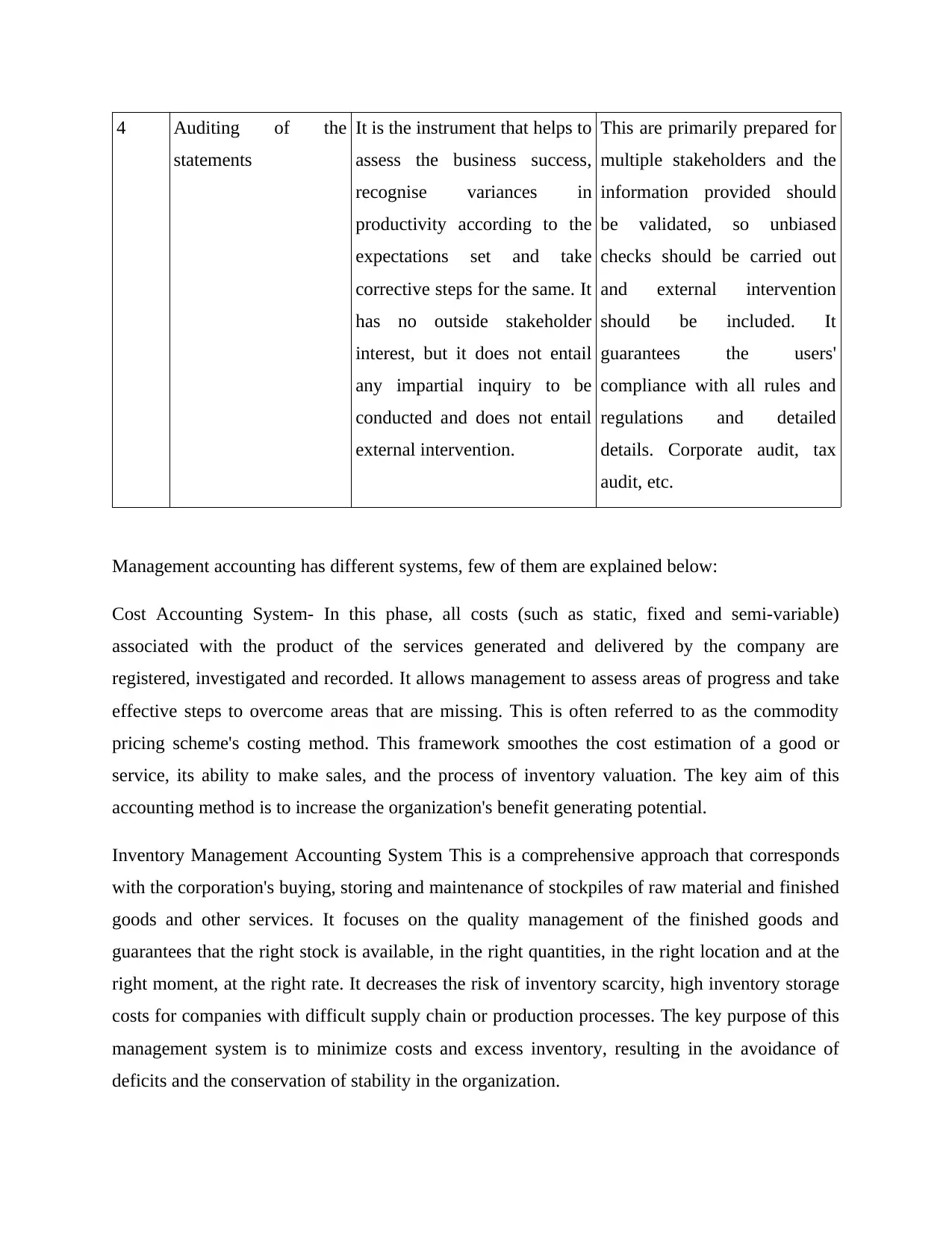
4 Auditing of the
statements
It is the instrument that helps to
assess the business success,
recognise variances in
productivity according to the
expectations set and take
corrective steps for the same. It
has no outside stakeholder
interest, but it does not entail
any impartial inquiry to be
conducted and does not entail
external intervention.
This are primarily prepared for
multiple stakeholders and the
information provided should
be validated, so unbiased
checks should be carried out
and external intervention
should be included. It
guarantees the users'
compliance with all rules and
regulations and detailed
details. Corporate audit, tax
audit, etc.
Management accounting has different systems, few of them are explained below:
Cost Accounting System- In this phase, all costs (such as static, fixed and semi-variable)
associated with the product of the services generated and delivered by the company are
registered, investigated and recorded. It allows management to assess areas of progress and take
effective steps to overcome areas that are missing. This is often referred to as the commodity
pricing scheme's costing method. This framework smoothes the cost estimation of a good or
service, its ability to make sales, and the process of inventory valuation. The key aim of this
accounting method is to increase the organization's benefit generating potential.
Inventory Management Accounting System This is a comprehensive approach that corresponds
with the corporation's buying, storing and maintenance of stockpiles of raw material and finished
goods and other services. It focuses on the quality management of the finished goods and
guarantees that the right stock is available, in the right quantities, in the right location and at the
right moment, at the right rate. It decreases the risk of inventory scarcity, high inventory storage
costs for companies with difficult supply chain or production processes. The key purpose of this
management system is to minimize costs and excess inventory, resulting in the avoidance of
deficits and the conservation of stability in the organization.
statements
It is the instrument that helps to
assess the business success,
recognise variances in
productivity according to the
expectations set and take
corrective steps for the same. It
has no outside stakeholder
interest, but it does not entail
any impartial inquiry to be
conducted and does not entail
external intervention.
This are primarily prepared for
multiple stakeholders and the
information provided should
be validated, so unbiased
checks should be carried out
and external intervention
should be included. It
guarantees the users'
compliance with all rules and
regulations and detailed
details. Corporate audit, tax
audit, etc.
Management accounting has different systems, few of them are explained below:
Cost Accounting System- In this phase, all costs (such as static, fixed and semi-variable)
associated with the product of the services generated and delivered by the company are
registered, investigated and recorded. It allows management to assess areas of progress and take
effective steps to overcome areas that are missing. This is often referred to as the commodity
pricing scheme's costing method. This framework smoothes the cost estimation of a good or
service, its ability to make sales, and the process of inventory valuation. The key aim of this
accounting method is to increase the organization's benefit generating potential.
Inventory Management Accounting System This is a comprehensive approach that corresponds
with the corporation's buying, storing and maintenance of stockpiles of raw material and finished
goods and other services. It focuses on the quality management of the finished goods and
guarantees that the right stock is available, in the right quantities, in the right location and at the
right moment, at the right rate. It decreases the risk of inventory scarcity, high inventory storage
costs for companies with difficult supply chain or production processes. The key purpose of this
management system is to minimize costs and excess inventory, resulting in the avoidance of
deficits and the conservation of stability in the organization.
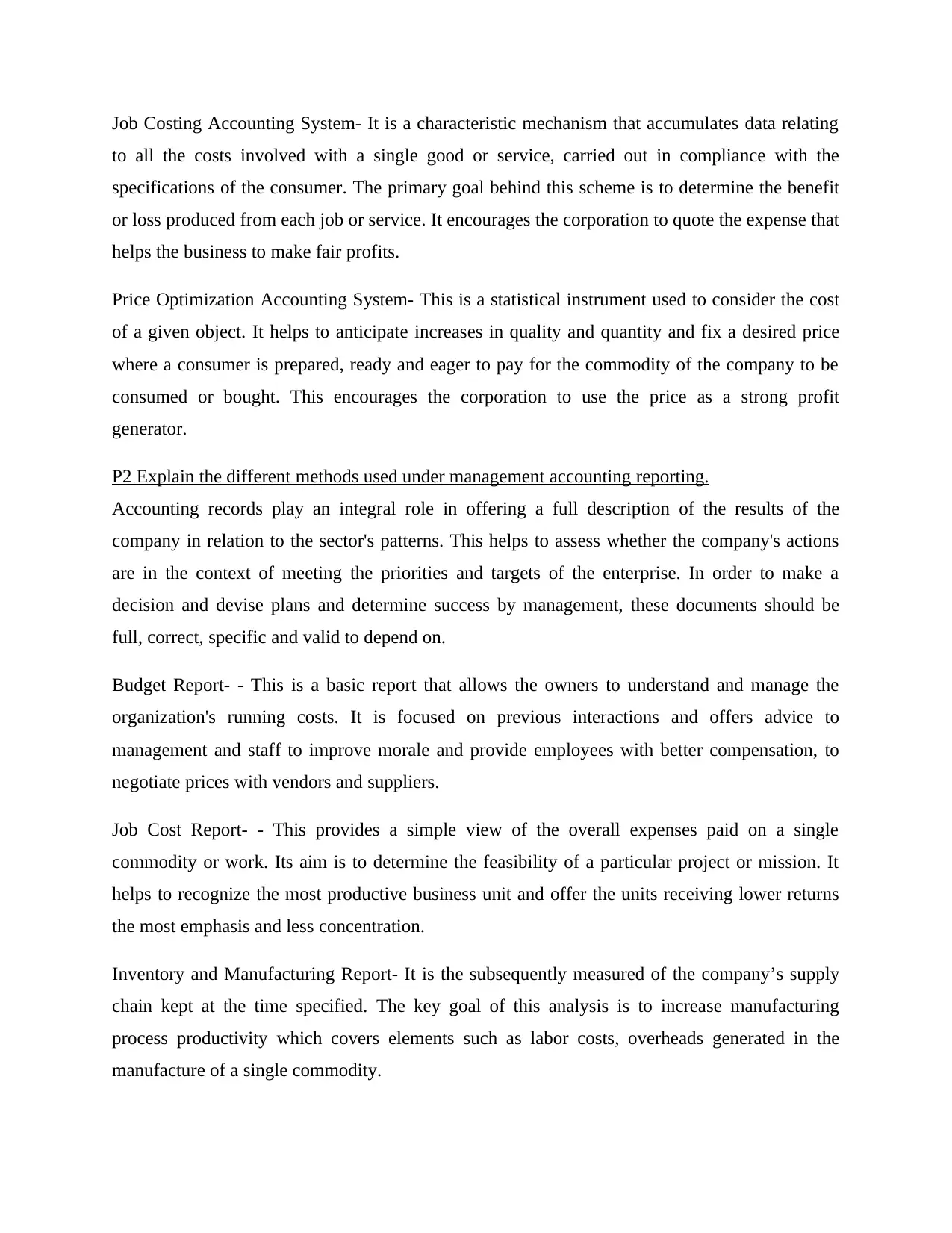
Job Costing Accounting System- It is a characteristic mechanism that accumulates data relating
to all the costs involved with a single good or service, carried out in compliance with the
specifications of the consumer. The primary goal behind this scheme is to determine the benefit
or loss produced from each job or service. It encourages the corporation to quote the expense that
helps the business to make fair profits.
Price Optimization Accounting System- This is a statistical instrument used to consider the cost
of a given object. It helps to anticipate increases in quality and quantity and fix a desired price
where a consumer is prepared, ready and eager to pay for the commodity of the company to be
consumed or bought. This encourages the corporation to use the price as a strong profit
generator.
P2 Explain the different methods used under management accounting reporting.
Accounting records play an integral role in offering a full description of the results of the
company in relation to the sector's patterns. This helps to assess whether the company's actions
are in the context of meeting the priorities and targets of the enterprise. In order to make a
decision and devise plans and determine success by management, these documents should be
full, correct, specific and valid to depend on.
Budget Report- - This is a basic report that allows the owners to understand and manage the
organization's running costs. It is focused on previous interactions and offers advice to
management and staff to improve morale and provide employees with better compensation, to
negotiate prices with vendors and suppliers.
Job Cost Report- - This provides a simple view of the overall expenses paid on a single
commodity or work. Its aim is to determine the feasibility of a particular project or mission. It
helps to recognize the most productive business unit and offer the units receiving lower returns
the most emphasis and less concentration.
Inventory and Manufacturing Report- It is the subsequently measured of the company’s supply
chain kept at the time specified. The key goal of this analysis is to increase manufacturing
process productivity which covers elements such as labor costs, overheads generated in the
manufacture of a single commodity.
to all the costs involved with a single good or service, carried out in compliance with the
specifications of the consumer. The primary goal behind this scheme is to determine the benefit
or loss produced from each job or service. It encourages the corporation to quote the expense that
helps the business to make fair profits.
Price Optimization Accounting System- This is a statistical instrument used to consider the cost
of a given object. It helps to anticipate increases in quality and quantity and fix a desired price
where a consumer is prepared, ready and eager to pay for the commodity of the company to be
consumed or bought. This encourages the corporation to use the price as a strong profit
generator.
P2 Explain the different methods used under management accounting reporting.
Accounting records play an integral role in offering a full description of the results of the
company in relation to the sector's patterns. This helps to assess whether the company's actions
are in the context of meeting the priorities and targets of the enterprise. In order to make a
decision and devise plans and determine success by management, these documents should be
full, correct, specific and valid to depend on.
Budget Report- - This is a basic report that allows the owners to understand and manage the
organization's running costs. It is focused on previous interactions and offers advice to
management and staff to improve morale and provide employees with better compensation, to
negotiate prices with vendors and suppliers.
Job Cost Report- - This provides a simple view of the overall expenses paid on a single
commodity or work. Its aim is to determine the feasibility of a particular project or mission. It
helps to recognize the most productive business unit and offer the units receiving lower returns
the most emphasis and less concentration.
Inventory and Manufacturing Report- It is the subsequently measured of the company’s supply
chain kept at the time specified. The key goal of this analysis is to increase manufacturing
process productivity which covers elements such as labor costs, overheads generated in the
manufacture of a single commodity.
⊘ This is a preview!⊘
Do you want full access?
Subscribe today to unlock all pages.

Trusted by 1+ million students worldwide

Order Information Report- It enables the measurement of productivity and performance in
market patterns. It consists of details about the different orders issued by the organization. It
allows the corporation to maintain cost leadership and combines numerous management
practices.
Accounts Receivable Aging Report- It is linked to shoppers' credit balances. It aligns the strategy
of the organization with its customers' paying ability. It is used by executives to recognize the
challenges associated with the credit policies of the company. This guarantees the reduction of
old loans that are actually poor debts.
Performance Report- A negative perception of the success of the company is given in this report.
It summarizes the final outcome of all the tasks or an individual's success in terms of the work
undertaken. It is the normal performance sets, the detection of anomalies and the proper steps to
resolve performance differences. This covers metrics such as milestones made, goals achieved,
projects completed, etc.
TASK 2
P3 Calculate costs using appropriate techniques of cost analysis to prepare an income statement
using marginal and absorption costs.
1 Preparation of income statements:
Cost per unit under absorption costing-
Activity April May
Variable Manufacturing cost per unit 4 4
Fixed Manufacturing Overhead per unit 6 5
Total 10 9
Income statement under absorption costing-
Particulars April May
market patterns. It consists of details about the different orders issued by the organization. It
allows the corporation to maintain cost leadership and combines numerous management
practices.
Accounts Receivable Aging Report- It is linked to shoppers' credit balances. It aligns the strategy
of the organization with its customers' paying ability. It is used by executives to recognize the
challenges associated with the credit policies of the company. This guarantees the reduction of
old loans that are actually poor debts.
Performance Report- A negative perception of the success of the company is given in this report.
It summarizes the final outcome of all the tasks or an individual's success in terms of the work
undertaken. It is the normal performance sets, the detection of anomalies and the proper steps to
resolve performance differences. This covers metrics such as milestones made, goals achieved,
projects completed, etc.
TASK 2
P3 Calculate costs using appropriate techniques of cost analysis to prepare an income statement
using marginal and absorption costs.
1 Preparation of income statements:
Cost per unit under absorption costing-
Activity April May
Variable Manufacturing cost per unit 4 4
Fixed Manufacturing Overhead per unit 6 5
Total 10 9
Income statement under absorption costing-
Particulars April May
Paraphrase This Document
Need a fresh take? Get an instant paraphrase of this document with our AI Paraphraser
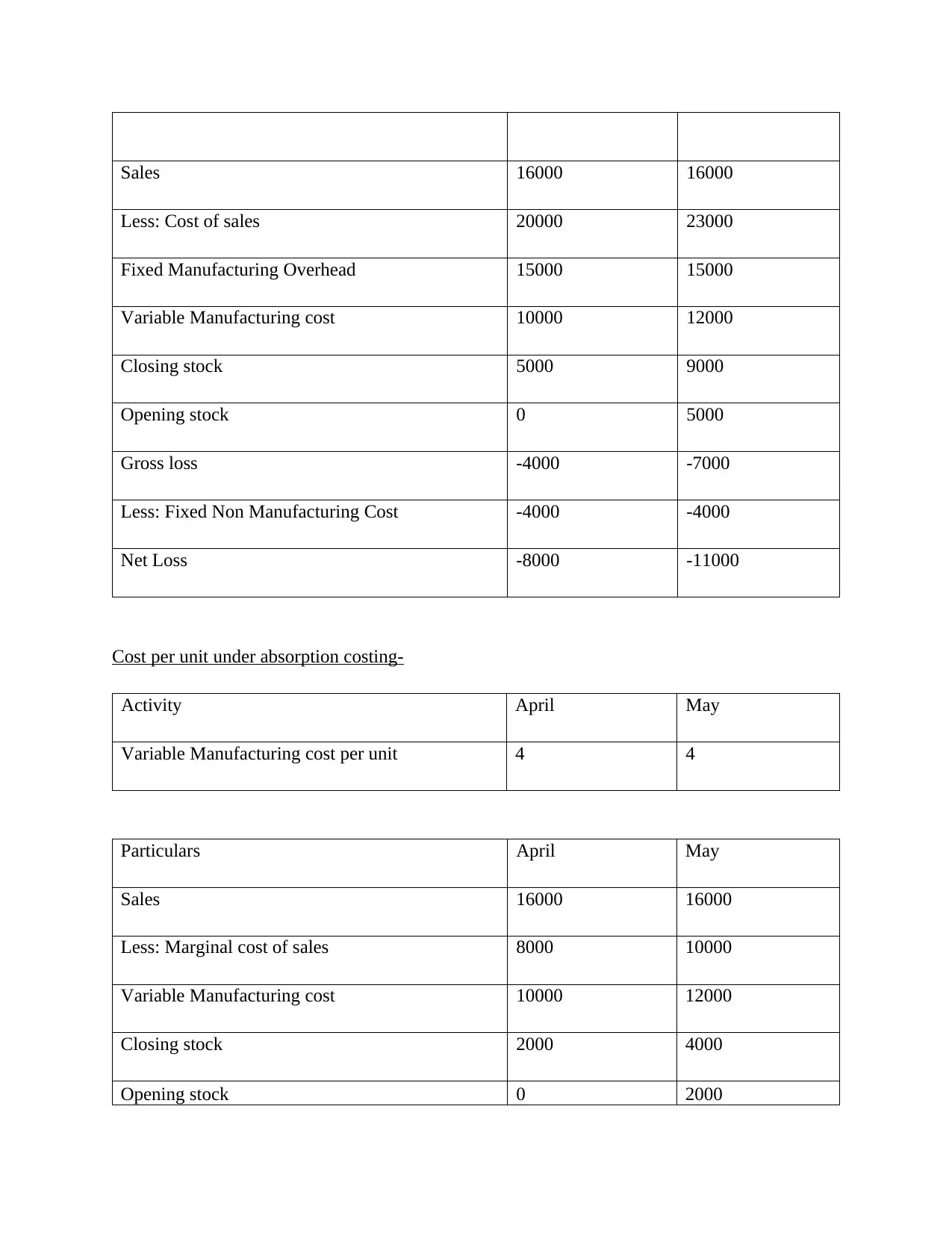
Sales 16000 16000
Less: Cost of sales 20000 23000
Fixed Manufacturing Overhead 15000 15000
Variable Manufacturing cost 10000 12000
Closing stock 5000 9000
Opening stock 0 5000
Gross loss -4000 -7000
Less: Fixed Non Manufacturing Cost -4000 -4000
Net Loss -8000 -11000
Cost per unit under absorption costing-
Activity April May
Variable Manufacturing cost per unit 4 4
Particulars April May
Sales 16000 16000
Less: Marginal cost of sales 8000 10000
Variable Manufacturing cost 10000 12000
Closing stock 2000 4000
Opening stock 0 2000
Less: Cost of sales 20000 23000
Fixed Manufacturing Overhead 15000 15000
Variable Manufacturing cost 10000 12000
Closing stock 5000 9000
Opening stock 0 5000
Gross loss -4000 -7000
Less: Fixed Non Manufacturing Cost -4000 -4000
Net Loss -8000 -11000
Cost per unit under absorption costing-
Activity April May
Variable Manufacturing cost per unit 4 4
Particulars April May
Sales 16000 16000
Less: Marginal cost of sales 8000 10000
Variable Manufacturing cost 10000 12000
Closing stock 2000 4000
Opening stock 0 2000
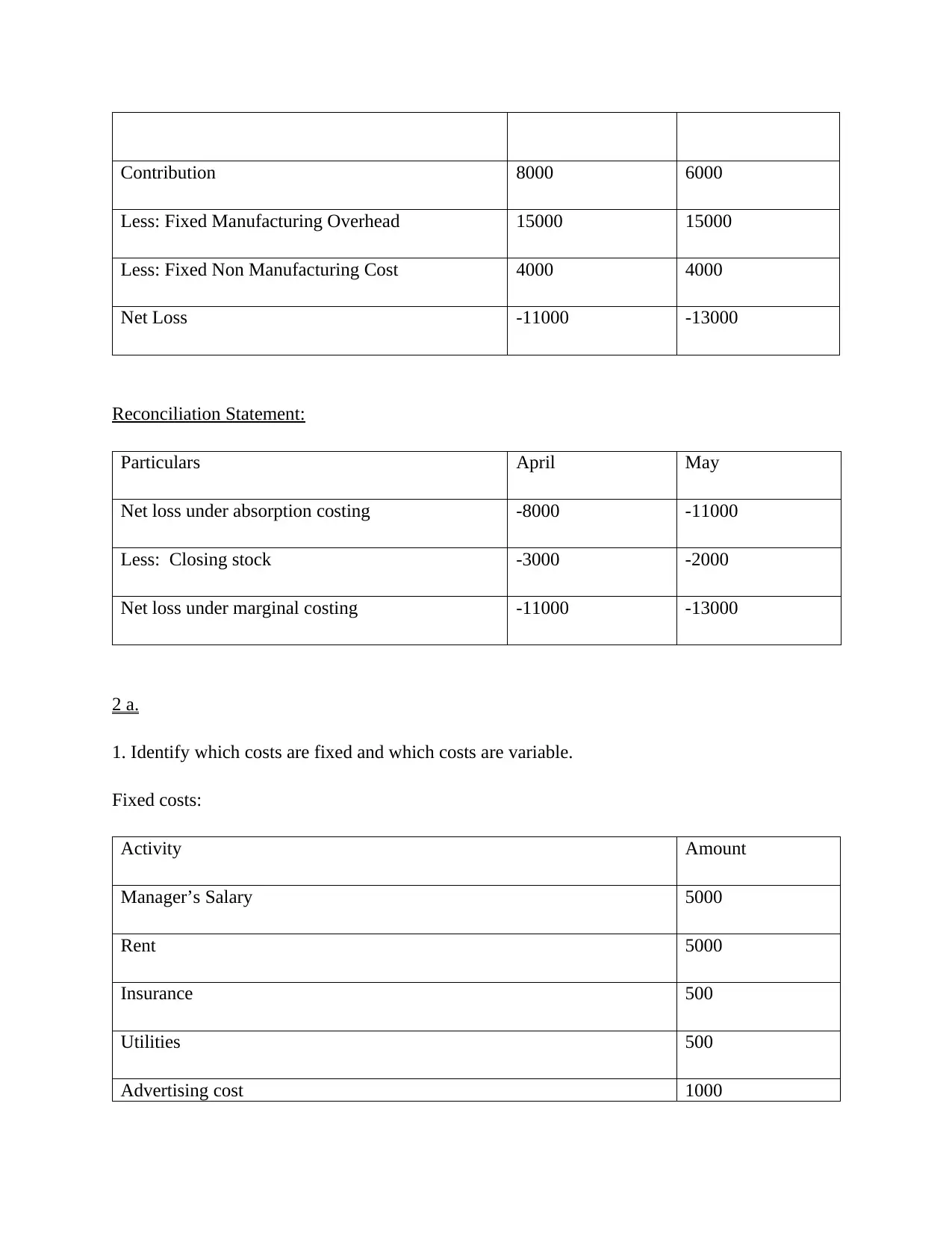
Contribution 8000 6000
Less: Fixed Manufacturing Overhead 15000 15000
Less: Fixed Non Manufacturing Cost 4000 4000
Net Loss -11000 -13000
Reconciliation Statement:
Particulars April May
Net loss under absorption costing -8000 -11000
Less: Closing stock -3000 -2000
Net loss under marginal costing -11000 -13000
2 a.
1. Identify which costs are fixed and which costs are variable.
Fixed costs:
Activity Amount
Manager’s Salary 5000
Rent 5000
Insurance 500
Utilities 500
Advertising cost 1000
Less: Fixed Manufacturing Overhead 15000 15000
Less: Fixed Non Manufacturing Cost 4000 4000
Net Loss -11000 -13000
Reconciliation Statement:
Particulars April May
Net loss under absorption costing -8000 -11000
Less: Closing stock -3000 -2000
Net loss under marginal costing -11000 -13000
2 a.
1. Identify which costs are fixed and which costs are variable.
Fixed costs:
Activity Amount
Manager’s Salary 5000
Rent 5000
Insurance 500
Utilities 500
Advertising cost 1000
⊘ This is a preview!⊘
Do you want full access?
Subscribe today to unlock all pages.

Trusted by 1+ million students worldwide
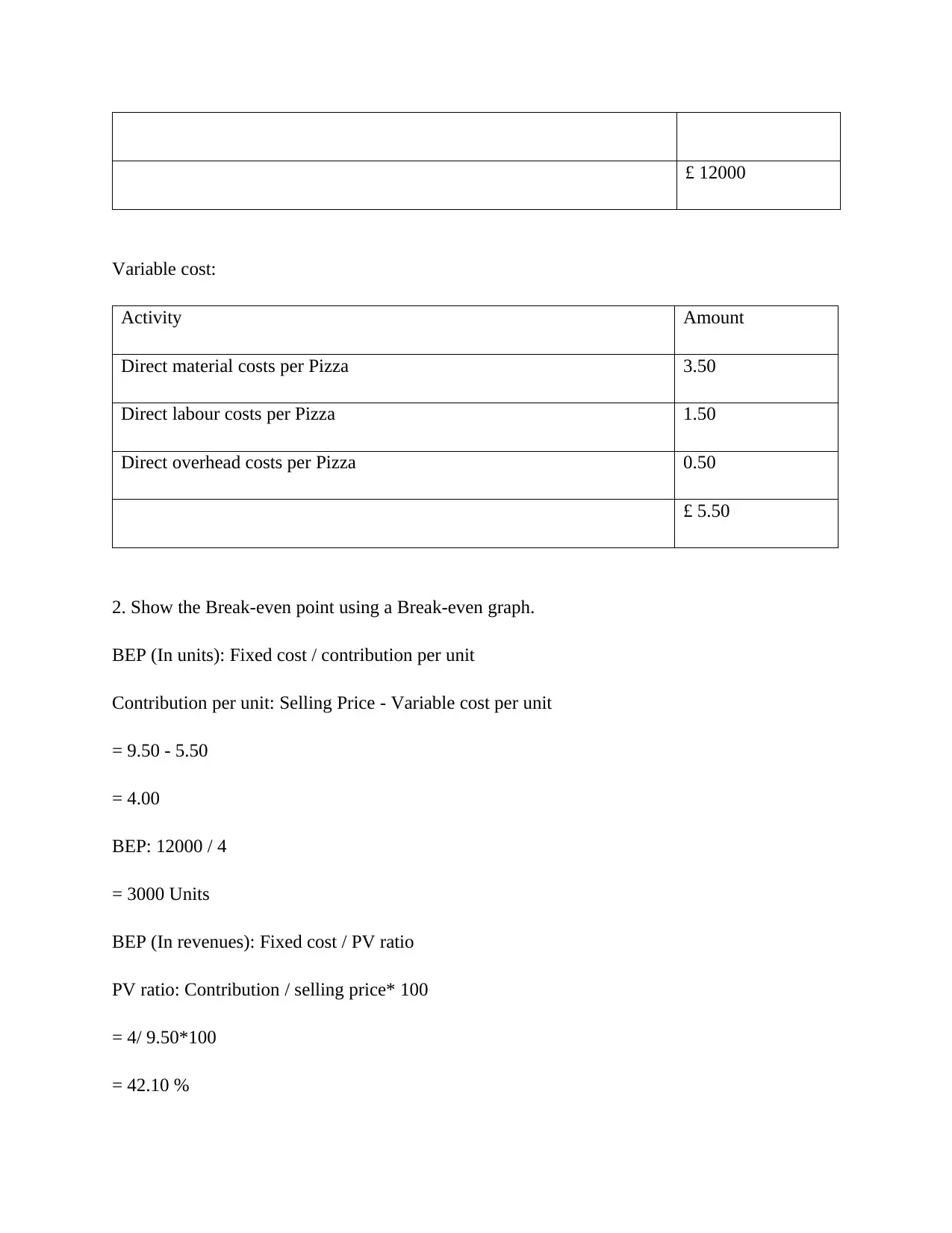
£ 12000
Variable cost:
Activity Amount
Direct material costs per Pizza 3.50
Direct labour costs per Pizza 1.50
Direct overhead costs per Pizza 0.50
£ 5.50
2. Show the Break-even point using a Break-even graph.
BEP (In units): Fixed cost / contribution per unit
Contribution per unit: Selling Price - Variable cost per unit
= 9.50 - 5.50
= 4.00
BEP: 12000 / 4
= 3000 Units
BEP (In revenues): Fixed cost / PV ratio
PV ratio: Contribution / selling price* 100
= 4/ 9.50*100
= 42.10 %
Variable cost:
Activity Amount
Direct material costs per Pizza 3.50
Direct labour costs per Pizza 1.50
Direct overhead costs per Pizza 0.50
£ 5.50
2. Show the Break-even point using a Break-even graph.
BEP (In units): Fixed cost / contribution per unit
Contribution per unit: Selling Price - Variable cost per unit
= 9.50 - 5.50
= 4.00
BEP: 12000 / 4
= 3000 Units
BEP (In revenues): Fixed cost / PV ratio
PV ratio: Contribution / selling price* 100
= 4/ 9.50*100
= 42.10 %
Paraphrase This Document
Need a fresh take? Get an instant paraphrase of this document with our AI Paraphraser
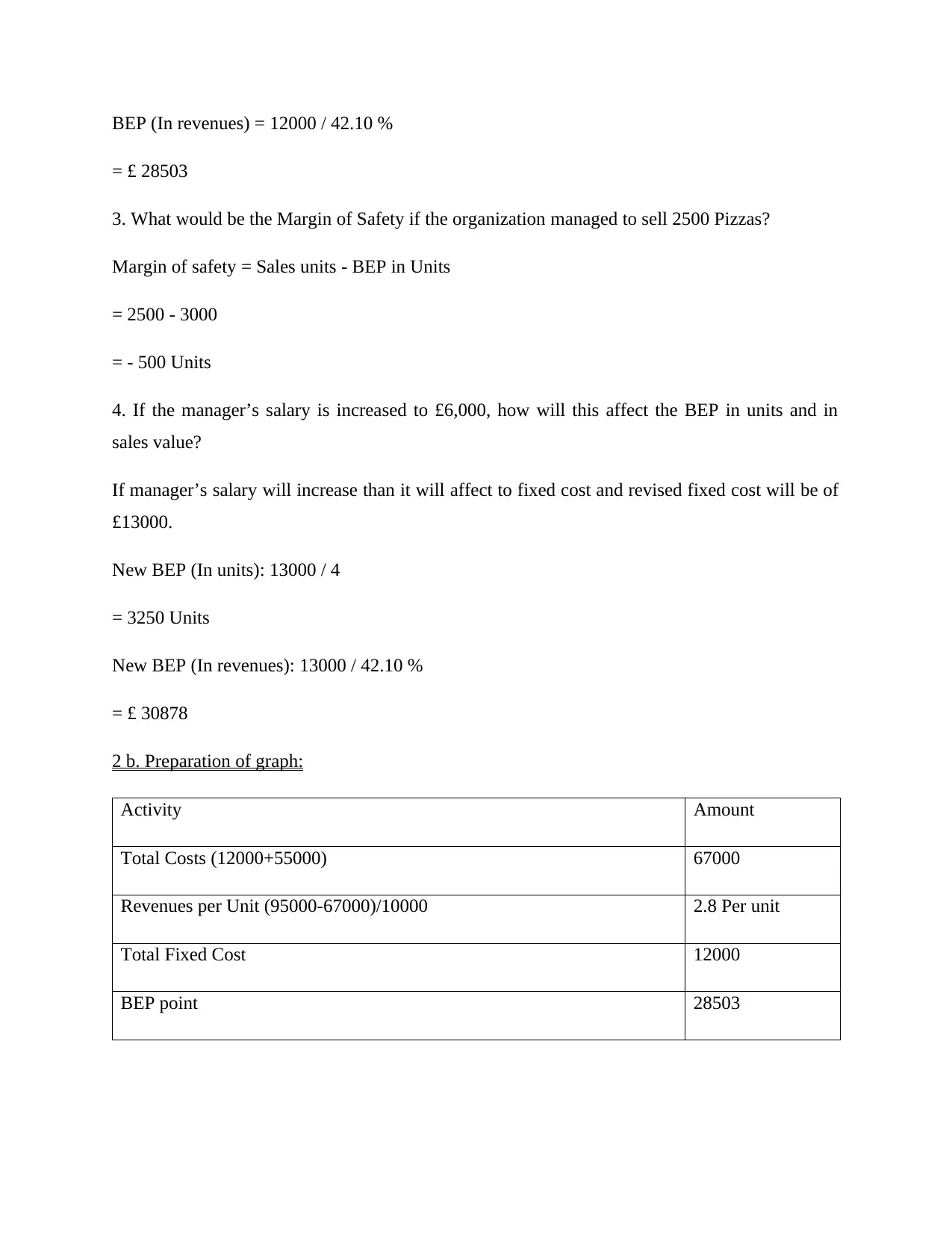
BEP (In revenues) = 12000 / 42.10 %
= £ 28503
3. What would be the Margin of Safety if the organization managed to sell 2500 Pizzas?
Margin of safety = Sales units - BEP in Units
= 2500 - 3000
= - 500 Units
4. If the manager’s salary is increased to £6,000, how will this affect the BEP in units and in
sales value?
If manager’s salary will increase than it will affect to fixed cost and revised fixed cost will be of
£13000.
New BEP (In units): 13000 / 4
= 3250 Units
New BEP (In revenues): 13000 / 42.10 %
= £ 30878
2 b. Preparation of graph:
Activity Amount
Total Costs (12000+55000) 67000
Revenues per Unit (95000-67000)/10000 2.8 Per unit
Total Fixed Cost 12000
BEP point 28503
= £ 28503
3. What would be the Margin of Safety if the organization managed to sell 2500 Pizzas?
Margin of safety = Sales units - BEP in Units
= 2500 - 3000
= - 500 Units
4. If the manager’s salary is increased to £6,000, how will this affect the BEP in units and in
sales value?
If manager’s salary will increase than it will affect to fixed cost and revised fixed cost will be of
£13000.
New BEP (In units): 13000 / 4
= 3250 Units
New BEP (In revenues): 13000 / 42.10 %
= £ 30878
2 b. Preparation of graph:
Activity Amount
Total Costs (12000+55000) 67000
Revenues per Unit (95000-67000)/10000 2.8 Per unit
Total Fixed Cost 12000
BEP point 28503

T ot a l Cos ts
( 12 0 0 0 +5 5 0 00 ) R e ve nue s pe r
U ni t ( 9 50 0 0 -
6 70 0 0 ) / 1 00 0 0
T ot a l F i xe d Cos t B E P poi nt
0
10000
20000
30000
40000
50000
60000
70000
80000
3. Variance Analysis Report:
Actual units sold = 12000
Budgeted units sold = 10000
Budgeted price per unit = 9.50
Sales volume variance = (Actual units sold - Budgeted units sold) x Budgeted price per unit
= (12000 - 10000) * 9.50
= 2000 * 9.50
= 19000 Favorable
Flexible budget
Items Actual Budgeted Variance
Sales price 10 9.50 0.50 Fav.
Sales units 12000 10000 2000 Fav.
Revenues 120000 95000 25000 Fav.
( 12 0 0 0 +5 5 0 00 ) R e ve nue s pe r
U ni t ( 9 50 0 0 -
6 70 0 0 ) / 1 00 0 0
T ot a l F i xe d Cos t B E P poi nt
0
10000
20000
30000
40000
50000
60000
70000
80000
3. Variance Analysis Report:
Actual units sold = 12000
Budgeted units sold = 10000
Budgeted price per unit = 9.50
Sales volume variance = (Actual units sold - Budgeted units sold) x Budgeted price per unit
= (12000 - 10000) * 9.50
= 2000 * 9.50
= 19000 Favorable
Flexible budget
Items Actual Budgeted Variance
Sales price 10 9.50 0.50 Fav.
Sales units 12000 10000 2000 Fav.
Revenues 120000 95000 25000 Fav.
⊘ This is a preview!⊘
Do you want full access?
Subscribe today to unlock all pages.

Trusted by 1+ million students worldwide
1 out of 19
Related Documents
Your All-in-One AI-Powered Toolkit for Academic Success.
+13062052269
info@desklib.com
Available 24*7 on WhatsApp / Email
![[object Object]](/_next/static/media/star-bottom.7253800d.svg)
Unlock your academic potential
Copyright © 2020–2025 A2Z Services. All Rights Reserved. Developed and managed by ZUCOL.


